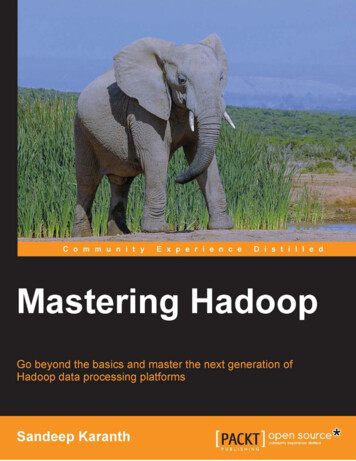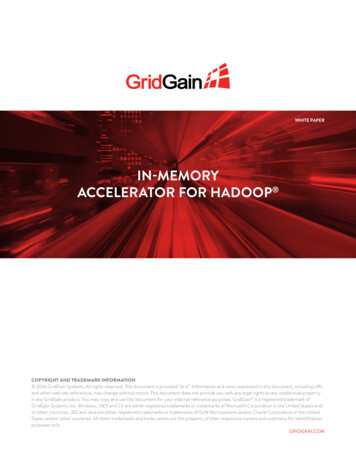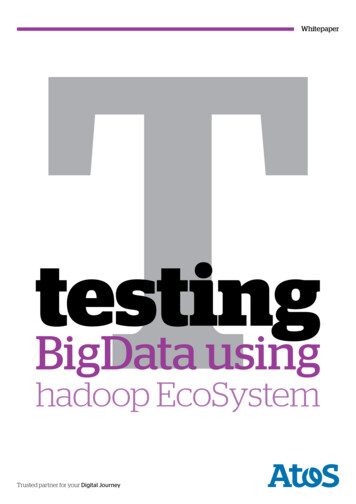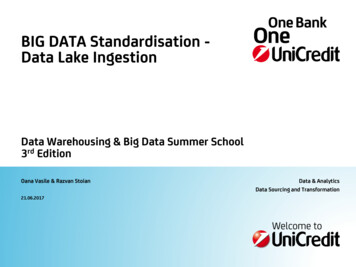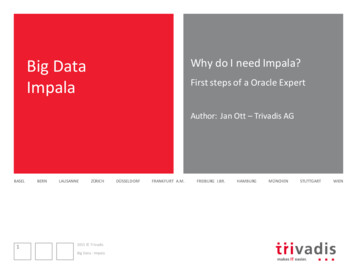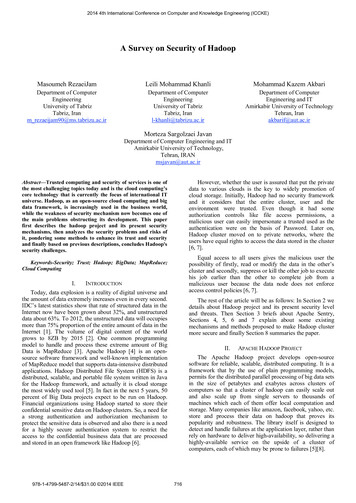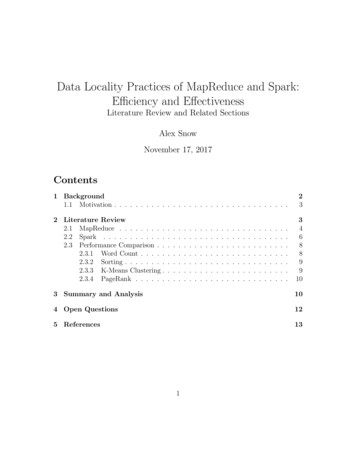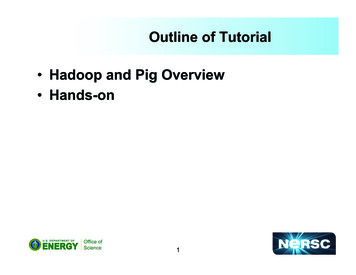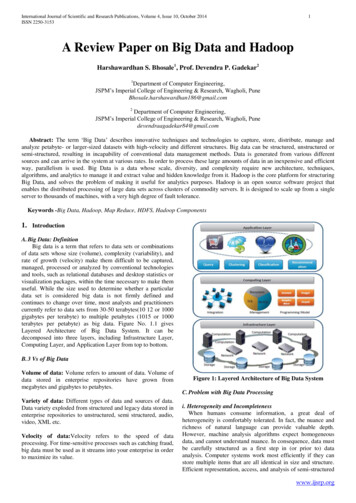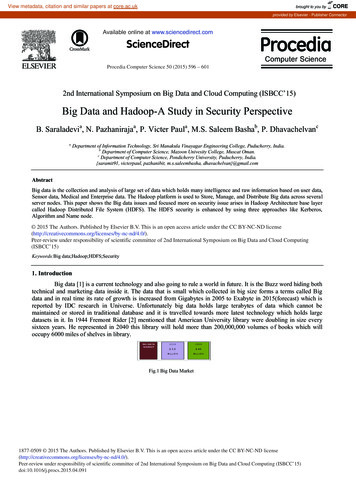
Transcription
View metadata, citation and similar papers at core.ac.ukbrought to you byCOREprovided by Elsevier - Publisher ConnectorAvailable online at www.sciencedirect.comScienceDirectProcedia Computer Science 50 (2015) 596 – 6012nd International Symposium on Big Data and Cloud Computing (ISBCC’15)Big Data and Hadoop-A Study in Security PerspectiveB. Saraladevia, N. Pazhanirajaa, P. Victer Paula, M.S. Saleem Bashab, P. DhavachelvancaDepartment of Information Technology, Sri Manakula Vinayagar Engineering College, Puducherry, India.bDepartment of Computer Science, Mazoon Univesity College, Muscat Oman.cDepartment of Computer Science, Pondicherry University, Puducherry, India.{saramit91, victerpaul, pazhanibit, m.s.saleembasha, dhavachelvan}@gmail.comAbstractBig data is the collection and analysis of large set of data which holds many intelligence and raw information based on user data,Sensor data, Medical and Enterprise data. The Hadoop platform is used to Store, Manage, and Distribute Big data across severalserver nodes. This paper shows the Big data issues and focused more on security issue arises in Hadoop Architecture base layercalled Hadoop Distributed File System (HDFS). The HDFS security is enhanced by using three approaches like Kerberos,Algorithm and Name node. 20152015 TheThe Authors.Authors. PublishedPublished byby ElsevierElsevier B.V.B.V.This is an open access article under the CC BY-NC-ND nd/4.0/).Peer-review under responsibility of scientific committee of 2nd International Symposium on Big Data and Cloud ComputingPeer-review(ISBCC’15).under responsibility of scientific committee of 2nd International Symposium on Big Data and Cloud Computing(ISBCC’15)Keywords:Big data;Hadoop;HDFS;Security1. IntroductionBig data [1] is a current technology and also going to rule a world in future. It is the Buzz word hiding bothtechnical and marketing data inside it. The data that is small which collected in big size forms a terms called Bigdata and in real time its rate of growth is increased from Gigabytes in 2005 to Exabyte in 2015(forecast) which isreported by IDC research in Universe. Unfortunately big data holds large terabytes of data which cannot bemaintained or stored in traditional database and it is travelled towards more latest technology which holds largedatasets in it. In 1944 Fremont Rider [2] mentioned that American University library were doubling in size everysixteen years. He represented in 2040 this library will hold more than 200,000,000 volumes of books which willoccupy 6000 miles of shelves in library.Fig.1 Big Data Market1877-0509 2015 The Authors. Published by Elsevier B.V. This is an open access article under the CC BY-NC-ND nd/4.0/).Peer-review under responsibility of scientific committee of 2nd International Symposium on Big Data and Cloud Computing (ISBCC’15)doi:10.1016/j.procs.2015.04.091
B. Saraladevi et al. / Procedia Computer Science 50 (2015) 596 – 601The Fig 1 shows the future of big data market which is announced by International Data Corporation in March2012. There are more 1 billion people using a mobile for transferring information per month where these data aremonitored by telecommunication big data centre and allows the data centre to store more than 621 petabytes of dataper year. The big data analytics [3] allows quickly identifying the risks and opportunities and also increasingcapabilities of predictive analysis and Big Data Characteristics [22].Table.1 Difference between Traditional Data and Big data.1.2 Big Data IssuesThere are many issues arising in big data. They are Management issues, Processing Issues [24], Security issues, andStorage issues [25]. Each issue has its own task of surviving in big data and mainly focusing on security issues.a. Management IssuesThe biggest data management [23] is the collection of large volumes of Structured, Semi structured andunstructured data from the organization, Government sector and Private and Public Administration. The motto ofbig data management is ensuring a high data quality, data ownership, responsibilities, standardization,documentation and accessibility of data set. According to Gartner [4]”Big data” Challenge Involves More than JustManaging Volumes of Data mentioned in his Article.b. Storage IssuesThe Storage is achieved using virtualization in big data where it holds large set of Sensor information,media, videos, E-business transaction records, Cell Phone Signal Coordinates. Many Big data Storage CompaniesLike EMC [12], IBM, Netapp, Amazon Handles a data in a Large volume by using some tools like NoSQL, ApacheDrill, Horton Works [13], SAMOA, IKANOW, Hadoop, Map reduce, Grid Gain.c. Processing IssueThe big data processing analyzes the big data size in Petabyte, Exabyte or even in Zettabyte either in BatchProcessing or Stream Processing.d. Security IssuesThere are fewer challenges for managing a large data set in secure manner and inefficient tools, public andprivate database contain more threats and vulnerabilities, volunteered and unexpected leakage of data, anddeficiency of Public and Private Policy makes a hackers to collect their resources whenever required. In Distributedprogramming frameworks, the security issues start working when massive amount of private data stored in adatabase which is not encrypted or in regular format. Securing the data in presence of untrusted people is moredifficult and when moving from homogeneous data to the Heterogeneous data certain tools and technologies formassive data set is not often developed with more security and policy certificates. Sometimes data hackers andsystem hackers involves in collecting a publicly available big data set, copy it and store it in a devices like USBdrives, hard disk or in Laptops. They involves in attacking the data storage by sending some attacks like Denial ofService [14],Snoofing attack and Brute Force attack [15]. If the unknown user knows about the key value pairs ofdata it makes them to collect atleast some insufficient information. When the Storage of data increases from singletier to Multi storage tier the security tier must also be increased. In order to reduce these issues some cryptographicFramework techniques and robust algorithm must be developed in order to enhance the security of data for future.Similarly some tools are developed like Hadoop; NoSQL technology can be used for big data storage. In our597
598B. Saraladevi et al. / Procedia Computer Science 50 (2015) 596 – 601proposed work some ideas are given to overcome security issues in Hadoop environment.2.HadoopHadoop (Highly Archived Distributed Object Oriented Programming) was created by Goug Cutting andMike Cafarella in 2005 for supporting a distributed search Engine Project. It is an Open source Java Frameworktechnology helps to store, access and gain large resources from big data in a distributed fashion at less cost,highdegree of fault tolerance and high scalability. Hadoop [5] handles large number of data from different system likeImages,videos, Audios, Folders, Files, Software, Sensor Records, Communication data, Structured Query,unstructured data, Email& conversations, and anything which we can't think in any format. All these resources canbe stored in a Hadoop cluster without any schema representation instead of collecting from different systems. Thereare many components involved in Hadoop like Avro, Chukwa, Flume, HBase, Hive, Lucene, Oozie, Pig, Sqoop andZookeeper. The Hadoop Package also provides Documentation, source code, location awareness, Work scheduling.A Hadoop cluster contains one Master node and Many Slave nodes. The master node consists of Data node,Namenode, Job Tracker and Task Tracker where slave node acts as both a TaskTracker and Data node which holdscompute only and data only worker node. The Job Tracker manages the job scheduling. Basically Hadoop consistsof two Parts. They are Hadoop Distributed File system (HDFS) and Map Reduce[6].HDFS provides Storage of dataand Map Reduce provides Analysis of data in clustered environment.The Architecture of Hadoop is represented infigure 3.Fig.3 Hadoop Architecture2.1HDFS ArchitectureThe HDFS is the Java portable file system which is more scalable, reliable, distributed in the Hadoopframework environment. A Hadoop cluster contains the combination of single Name node and group of Data nodes.Using Commodity Hardware it provides redundant storage of large amounts of data with low latency where itperforms the operations like “Write Once, Read Many Times”. The files are stored as Block with default size of64MB.The communication between the nodes occurs through Remote Procedure calls. Name node stores metadatalike the name, replicas,file attributes,locations of each block address and the fast lookup of metadata is stored inRandom Access Memory by Metadata. It also reduces the data loss and prevents corruption of the file system.Namenode only monitors the number of blocks in data node and if any block lost or failed in the replica of a datanode,thename node creates another replica of the same block.Each block in the data node is maintained with timestamp toidentify the current status. If any failure occurs in the node, it need not be repair immediately it can be repairedperiodically. HDFS [7] allows more than 1000 nodes by a single Operator. Each block is replicated across manydata nodes where original data node is mentioned as rack 1 and replicated node as rack 2 in Hadoop framework andnever supports Data[21] Cache [19][20] due to Large set of data. The architecture of HDFS is shown in Figure 4.i) Security Issues in HDFSThe HDFS is the base layer of Hadoop Architecture contains different classifications of data and it is moresensitive to security issues. It has no appropriate role based access for controlling security problems.Also the risk ofdata access,theft,and unwanted disclosure takes place when embedded a data in single Hadoopenvironment.Thereplicated data is also not secure which needs more security for protecting from breaches andvulnerabilities. Mostly Government Sector and Organisations never using Hadoop environment for storing valuabledata because of less security concerns inside a Hadoop Technology. They are providing security in outside ofHadoop Environment like firewall and Intrusion Detection System. Some authors represented that the HDFS in
B. Saraladevi et al. / Procedia Computer Science 50 (2015) 596 – 601599Hadoop environment is prevented with security for avoiding the theft, vulnerabilities only by encrypting the blocklevels and individual file system in Hadoop Environment.Even though other authors encrypted the block and nodesusing encryption technique but no perfect algorithm is mentioned to maintain the security in Hadoop Environment.In order to increase the security some approaches are mentioned below.Fig.4 HDFS Architectureii) HDFS Security ApproachesThe proposed work represents different Approaches for securing data in Hadoop distributed file system. Thefirst approach is based on Kerberos in HDFS.a. Kerberos MechanismKerberos [10] is the network authentication protocol which allows the node to transfer any file over non securechannel by a tool called ticket to prove their unique identification between them. This Kerberos mechanism is usedto enhance the security in HDFS. In HDFS the connection between client and Name node is achieved using RemoteProcedure Call [11] and the connection from Client (client uses HTTP) to Data node is Achieved using BlockTransfer. Here the Token or Kerberos is used to authenticate a RPC connection. If the Client needs to obtain a tokenmeans, the client makes use of Kerberos Authenticated Connection. Ticket Granting Ticket (TGT) or Service Ticketare used to authenticate a name node by using Kerberos. Both TGT and ST can be renewed after long running ofjobs while Kerberos is renewed, new TGT and ST is also issued and distributed to all task. The Key DistributionCentre (KDC) issues the Kerberos Service Ticket using TGT after getting request from task and network traffic isavoided to the KDC by using Tokens In name node, only the time period is extended but the ticket remain constant.The major advantage is even if the ticket is stolen by the attacker it can’t be renewed. We can also use anothermethod for providing security for file access in HDFS.If the client wants to access a block from the data node it must first contact the name node in order toidentify which data node holds the files of the blocks. Because of name node only authorize access to file permissionand issues a token called Block Token where data node verifies the token. The data node also issues a token calledName Token where it allows the Name node to enforce permission for correct control access on its data blocks.Block Token allows the data node to identify whether the client is authorized access to access data blocks. Theseblock token and Name Token is sent back to client who contains data block respective locations and you’re theauthorized person to access the location. These two methods are used to increase security by preventing fromunauthorized client must read and write in data blocks. The figure 5 shows the design view of Kerberos keydistribution centre.b. Bull Eye Algorithm ApproachIn big data the sensitive data are credit card numbers, passwords, account numbers, personal details arestored in a large technology called Hadoop. In order to increase the security in Hadoop base layer the new approachis introduced for securing sensitive information which is called “Bull Eye Approach”. This approach is introducedon Hadoop module to view all sensitive information in 360 to find whether all the secured information are stored
600B. Saraladevi et al. / Procedia Computer Science 50 (2015) 596 – 601without any risk, and allows the authorized person to preserve the personal information in a right way. Recently thisapproach is using in companies like Dateguise’s DGsecure[8] and Amazon Elastic Map Reduce[9]. The DGsecureCompany which is famous for providing a Data centric security and Governance solutions also involves in providinga security for Hadoop in the cloud. The data guise company is decided to maintain and provide security in Hadoopwherever it is located in cloud. Now a days the Companies are storing a more sensitive data in cloud because ofmore breaches taking place in traditional on premise data store. To increase the security in Hadoop base layers, theBull eye Approach also used in HDFS to provide security in 360 from node to node. This approach is implementedin Data node of rack 1, where it checks the sensitive data are stored properly in block without any risk and allowsonly the particular client to store in required blocks. It also bridges a gap between a data driven from original datanode and replicated data node. When the client wants to retrieve any data from replicating data nodes it alsomaintained by “Bull Eye Approach” and it checks where there is a proper relation between two racks. ThisAlgorithm allows the data nodes to be more secure, only the authorized person read or write about it. The algorithmcan be implemented below the data node where the client read or writes the data to store in blocks. It is not onlyimplemented in the rack 1 similarly it is implemented in Rack 2 in order to increase the security of the blocks insidethe data nodes in 360 . It checks for any attacks, breaches or theft of data taking place in the blocks of the data node.Sometimes data are encrypted for protection in data mode. These types of encrypted data also protected using thisAlgorithm in order to main order security. The Algorithm travels from less terabyte to multi-petabytes of semistructured, structured and unstructured data stored in HDFS layer in all angles. Mostly encryption and Wrapping ofdata occurs at the block levels of Hadoop rather than entire file level. This algorithm scans before the data is allowedto enter into the blocks and also after enters both rack 1 and rack 2. Thus, this Algorithm concentrates only on thesensitive data that matters about the information stored in the data nodes. In our work, we mentioned this newAlgorithm to enhance more security in the data nodes of HDFS.Fig.5 Kerberos Key Distribution Centrec. Namenode ApproachIn HDFS if there is any problem in Name node event and becomes unavailable, it makes the group ofsystem service and data stored in the HDFS make unavailable so it is not easy to access the data in secure way fromthis critical situation. In order to increase the security in data availability, it is achieved by using two Namenode.These two Name nodes servers are allowed to run successfully in the same cluster. These two redundant name nodesare provided by Name Node Security Enhance (NNSE), which holds Bull Eye Algorithm. It allows the Hadoopadministrator to run the options for two nodes. From these name node one acts as Master and other acts as a slave inorder to reduce an unnecessary or unexpected server crash and allows predicting from natural disasters. If the MasterName node crashes, the administrator needs to ask permission from Name Node Security Enhance to provide a datafrom a slave node in order to cover a time lagging and data unavailability in secure manner. Without gettingpermission from NNSE admin never retrieves the data from slave node to reduce the complex retrieval issue. If bothName node acts as a master there is a continuous risk occurs, reduces a secure data availability and bottleneck inperformance over a local area network or Wide Area Network. Thus in future we can also increase security by usingVital configuration that provides and ensures data is available in secured way to client by replicating many Namenode by Name Node Security Enhance in HDFS blocks between many data centres and clusters.
B. Saraladevi et al. / Procedia Computer Science 50 (2015) 596 – 6016013. DiscussionThe proposed work represents different Approaches for securing data in Hadoop distributed file system.Thefirst approach is based on Kerberos in HDFS, it is used to access a data blocks correctly and also only by anauthorised user. Here Ticket Granting Ticket and Service Ticket playing a major role in providing a security in namenode.The Second approach is based on Bull Eye Algorithm Approach explains about the security method from nodeto node and also scan the nodes in all the angles to prevent from attacks. The third approach is based on Name nodewhere the security is achieved by replicating [17] a name node to reduce the server crashes for future references.4. ConclusionThis paper shows the big data information and characteristics used in world wide. The issues are alsomentioned to give idea about the big data issues in real time. The security issue is pointed more in order to increasethe security in big data. We can improve security in big data by using any one of the approach or by combiningthese three approaches in Hadoop Distributed File System which is the base layer in Hadoop, where it contains largenumber of blocks. These approaches are introduced to overcome certain issues occurs in the name node and also inData node. In Future these approaches are also implemented in other layers of Hadoop Technology.References[1] Prof. Dr. Philippe Cudré-Mauroux, “An Introduction to BIG DATA”, June 6, 2013 Alliance EPFL, http://exascale.info/[2] Fremont Rider, “The future of the Research Library”, lar IntroductionAnalytics%20 Big%20Data Hadoop.pdf[4] Gartner, http://www.gartner.com/newsroom/id/2848718, STAMFORD, Conn., September 17, 2014[5] “Leveraging Massively Parallel Processing in an Oracle Environment for Big Data”, An Oracle White Paper, November 2010.[6]Jeffrey Dean and Sanjay Ghemawat, “Map Reduce: Simplified Data Processing on Large Clusters”, Google, Inc.[7] “Hadoop and HDFS:Storage for Next Generation Data Management”, Cloudera, Inc, 2014.[8]Data guise protect, http://www.dataguise.com/?q dataguise-dgsecure-platform[9] Parviz Deyhim, “Best Practices for Amazon EMR”, August 2013.[10] Al-Janabi, Rasheed, M.A.-S., “Public-Key Cryptography Enabled Kerberos Authentication”, IEEE, Developments in E-systems Engineering(DeSE), 2011[11] Heindel L.E, “Highly reliable synchronous and asynchronous remote procedure calls”, Conference Proceedings of the IEEE FifteenthAnnual International Phoenix Conference on computers and communications,1996.[12] The journey to big data, EMC2 Publications.[13] Horton Technical Preview for Apache Spark, Horton works Inc.[14] Shay Chen, “Application Denial of Service”, Hack tics Ltd, 2007.[15] Daniel J. Bernstein, “Understanding brute force”, National Science Foundation, Chicago.[16] Introduction to Pig, Cloud era, 2009.[17] P. Victer Paul, N. Saravanan, S.K.V. Jayakumar, P. Dhavachelvan and R. Baskaran, “QoS enhancements for global replication managementin peer to peer networks”, Future Generation Computer Systems, Elsevier, Volume 28, Issue 3, March 2012, Pages 573–582. ISSN: 0167739X.[18]Ashish Thusoo, Joydeep Sen Sarma, “Hive –A Petabyte Scale Data Warehouse Using Hadoop, Facebook Data Infrastructure Team.[19]P. Victer Paul, D. Rajaguru, N. Saravanan, R. Baskaran and P. Dhavachelvan, "Efficient service cache management in mobile P2Pnetworks", Future Generation Computer Systems, Elsevier, Volume 29, Issue 6, August 2013, Pages 1505–1521. ISSN: 0167-739X.[20]N. Saravanan, R. Baskaran, M. Shanmugam, M.S. SaleemBasha and P. Victer Paul, "An Effective Model for QoS Assessment in DataCaching in MANET Environments", International Journal of Wireless and Mobile Computing, Inderscience, Vol.6, No.5, 2013, pp.515-527.ISSN: 1741-1092.[21] R. Baskaran, P. Victer Paul and P. Dhavachelvan, "Ant Colony Optimization for Data Cache Technique in MANET", InternationalConference on Advances in Computing (ICADC 2012), Advances in Intelligent and Soft Computing" series, Volume 174, Springer, June2012, pp 873-878, ISBN: 978-81-322-0739-9.[22] https://www.ida.gov.sg/ ologyRoadmap/BigData.pdf[23] Philip Russom, “Managing Big Data”, TDWI research, Fourth Quarter 2013.[24] Changqing, “Big Data Processing in Cloud Computing Environments”, International Symposium on Pervasive Systems, Algorithms andNetworks, 2012[25] Young-Sae Song, “Storing Big Data- The rise of the Storage Cloud” , December, 2012.
Like EMC [12], IBM, Netapp, Amazon Handles a data in a Large volume by using some tools like NoSQL, Apache Drill, Horton Works [13], SAMOA, IKANOW, Hadoop, Map reduce, Grid Gain. c. Processing Issue The big data processing analyzes the big data size in Petabyte, Exabyte or even in Zettabyte either in Batch Processing or Stream Processing. d.

